Winter 2023/2024 snowfall predictions show a global weather signal from El Nino, currently still getting stronger and ready for Winter. From the United States to Canada and across the Atlantic to Europe, we will look at the latest snowfall forecasts and trends for the whole Winter, as February data is now also available.
But first, we will take a fast look at the leading global weather driver for the upcoming Winter, the ENSO anomaly in the Pacific Ocean. What does the latest ocean analysis data show, and what are the expectations for its development?
The main focus will be on the global long-range weather forecasting systems, where you will see the latest snowfall predictions for the upcoming Winter 2023/2024 and its month-by-month breakdown.
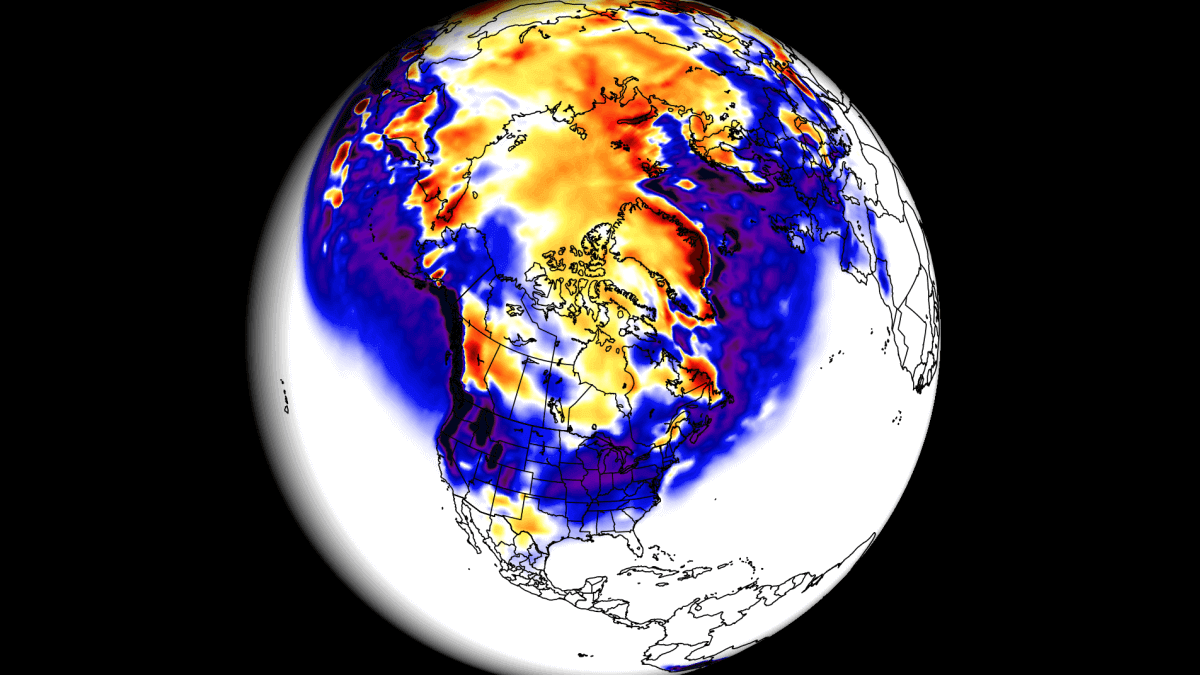
GLOBAL SEASONAL WEATHER INFLUENCE
ENSO is short for “El Nino Southern Oscillation.” This region of the equatorial Pacific Ocean changes between warm and cold phases. Typically, there is a phase change around every 1-3 years.
The cold phase is called La Nina, and the warm phase is called El Nino. We are currently in a strengthening El Nino phase, which will be at peak strength during the Winter season.
ENSO significantly influences tropical rainfall, pressure patterns, and the complex ocean and atmosphere exchange. We can observe large-scale pressure changes in the tropics with each new developing phase. These changes affect weather circulation over the rest of the world with some delay.
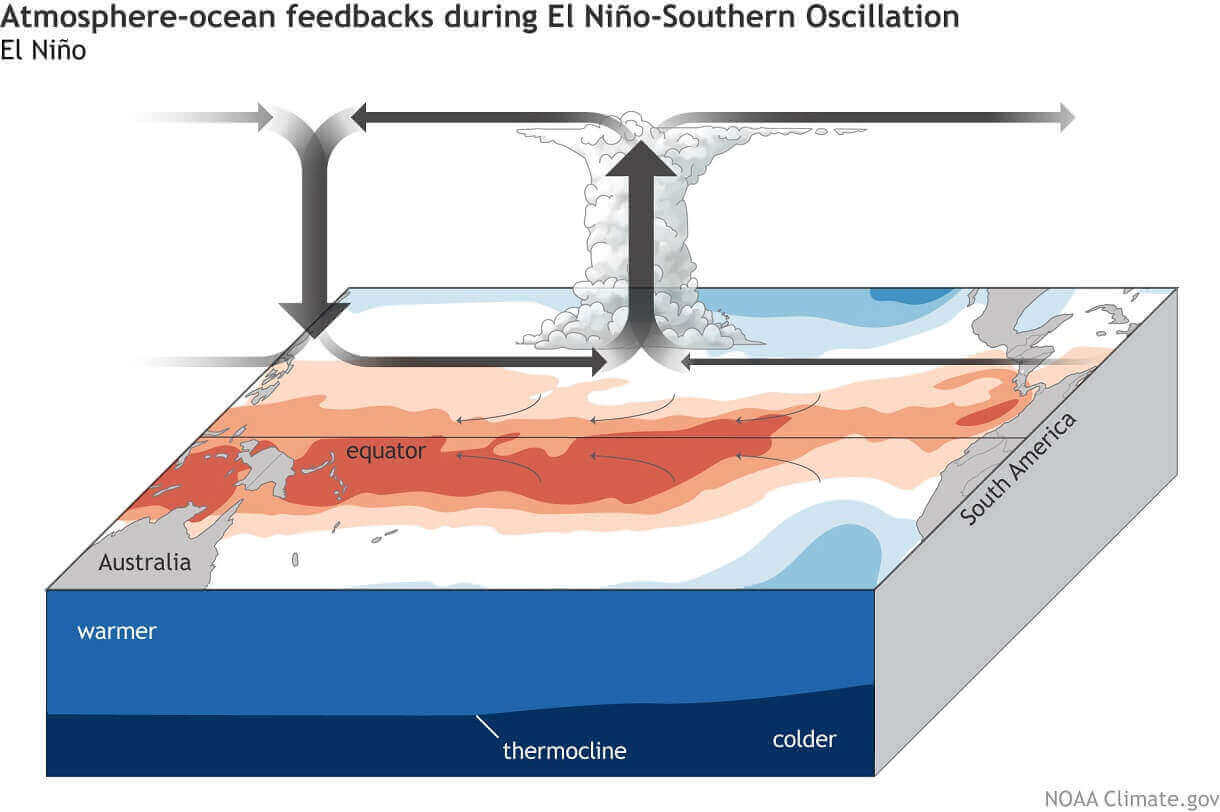
As you can see in the image above, a warm ENSO phase creates lower pressure than normal over the central and eastern Pacific Ocean and higher pressure in the west.
This way, it significantly alters the atmosphere-ocean feedback system. This feedback system spreads the ENSO influence globally, especially the Winter temperature and snowfall patterns.
You can see the El Nino in NOAA’s latest ocean anomaly analysis below. It can be seen as an area of above-normal ocean temperatures across the equatorial Pacific Ocean. This anomaly affects the atmosphere but also tells us that the weather patterns are changing globally.

El Nino usually forms during weak trade winds, which can tell us much about the state of global circulation. This way, we can use these ocean temperature anomalies as an “indicator” to know the current state of the global climate system.
Below, you can see the past year of ocean anomalies in the ENSO region. You can see the breakdown of the La Nina event last Winter and the fast rise in ocean temperatures. The forecast indicates a moderate to strong El Nino event for the upcoming Winter.
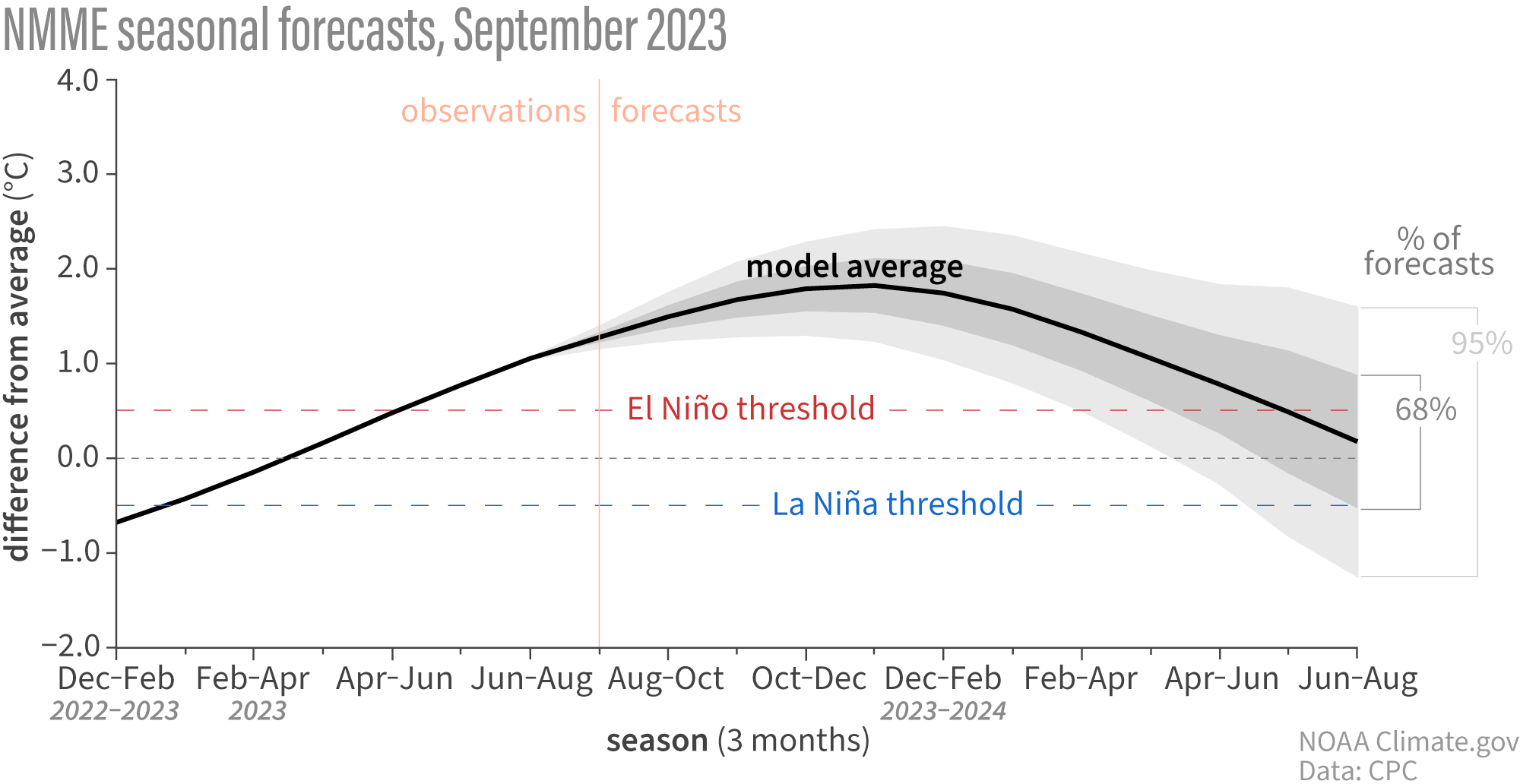
We produced a special video animation to better understand this ENSO phase shift. It shows the ocean surface anomalies from late Winter to Summer.
The cold La Nina quickly broke down over the Winter, with warmer anomalies emerging in early Spring. Notice the motion of the anomalies on the ocean surface, driven by the trade winds.
You can see just how fast the ocean anomalies transitioned from a La Nina phase and started showing an active El Nino signature.
ENSO WINTER FORECAST
Below, we have an Official NOAA CPC probability forecast graphic, which shows the long-range forecast of the central ENSO region. As forecasted, the El Nino conditions will last over the Fall and Winter. A weakening of the El Nino is expected for Spring, with a shift to a neutral phase into Summer.

So, what exactly does this mean for the winter weather patterns and snowfall potential? To answer that, we will take a closer look at the weather influence El Nino usually shows over North America, based on real observations.
Europe is not known to have any specific/direct influences, as it is too far from the source region. But that does not mean it has no impact. It is just harder to find a reliable long-term signal.
ENSO does change the weather globally. But apart from the direct influence over North America and other closer regions, places like Europe have many other factors at play before any direct weather influence reaches this far from the Pacific Ocean.
NORTH AMERICA WINTER WEATHER PATTERNS
Typically, the first influence of these ocean anomalies can be seen in the changes to the jet stream. The jet stream is a large and powerful stream of air (wind) at around 8-11km (5-7mi) altitude.
Historically, a strong low-pressure system in the North Pacific is the most typical effect of a warm ENSO phase (El Nino). That usually weakens the polar jet stream but strengthens the subtropical jet stream over the southern United States.
The image below shows the average position of the jet stream during El Nino winters and the resulting weather patterns over the United States and Canada. You can see the subtropical jet stream extension across the southern United States.
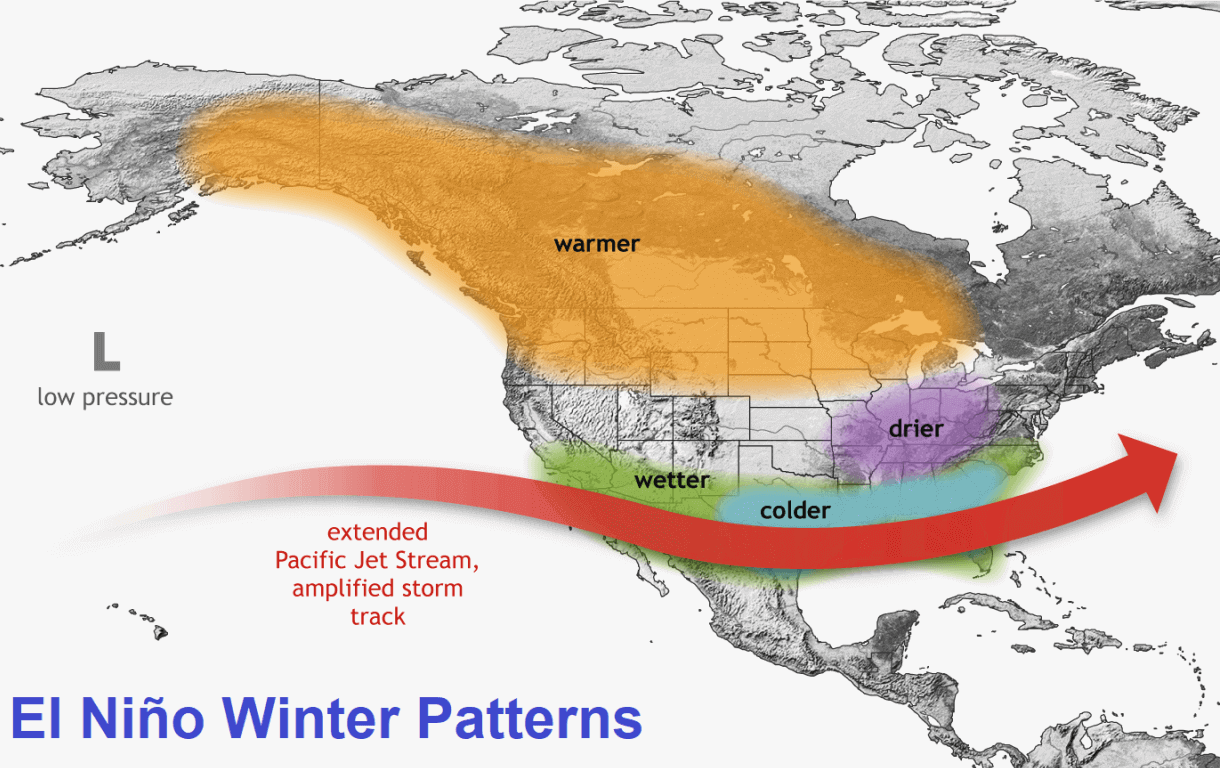
A stronger subtropical jet stream brings along lower pressure, cooler temperatures, and more moisture. That combination increases the snowfall potential across the central and eastern United States, provided enough cold air is available.
The image below shows the average pressure pattern during the last few El Nino Winters. You can see the main low-pressure area in the North Pacific and a blocking high over Canada. Image by NOAA Physical Sciences Laboratory (PSL).
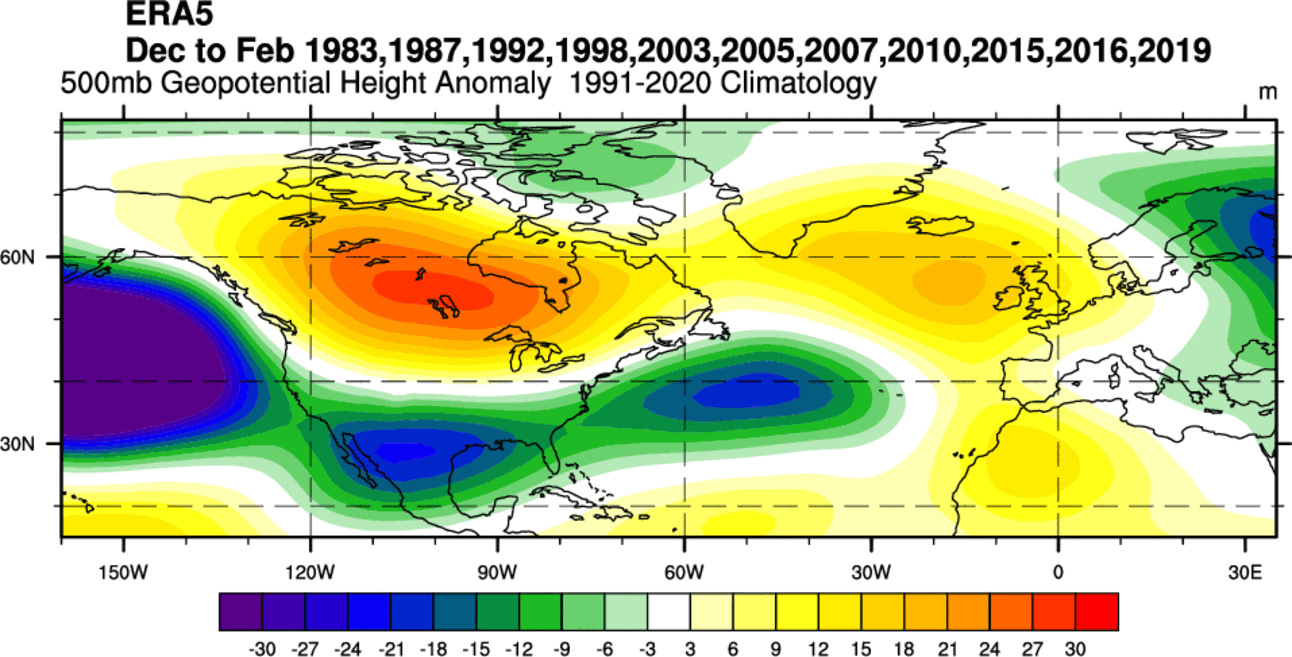
The high-pressure area over Canada means a low-pressure train over the southern half of the United States. This means extending the Pacific jet stream, bringing more moisture and precipitation to the southern United States, along with cooler temperatures.
Looking at the temperature anomalies in an average El Nino winter, you can see colder temperatures in the southern half of the United States and parts of the eastern United States. The northern United States and Canada are warmer than normal during an El Nino.
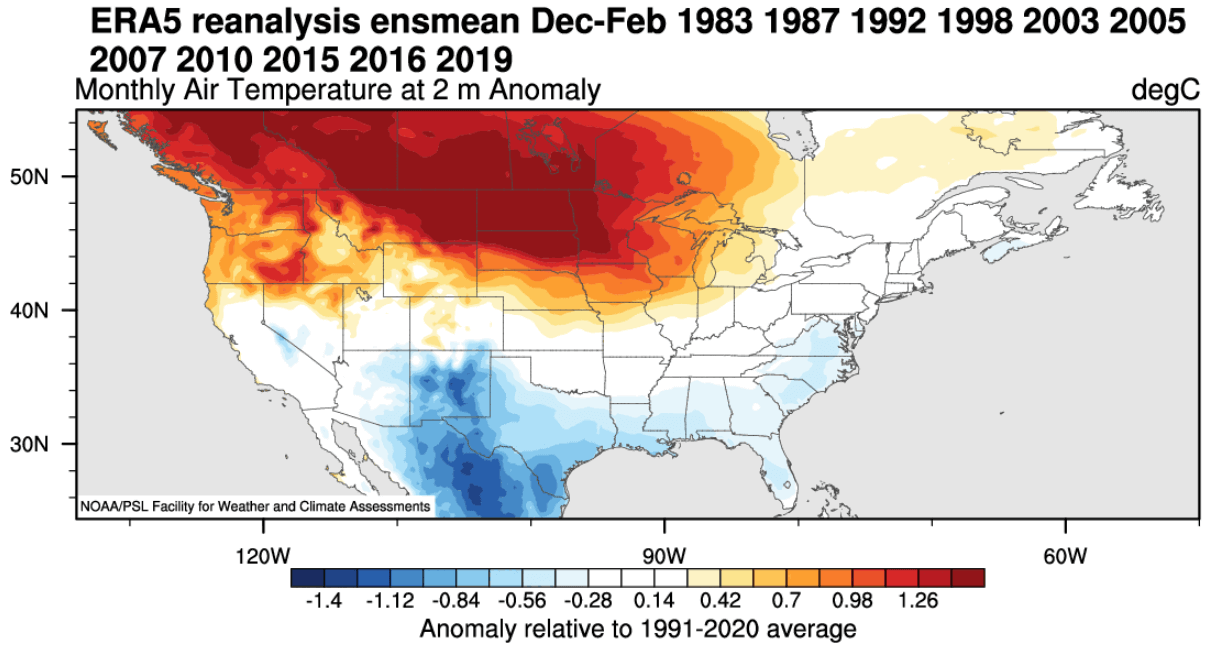
The main winter weather “battle zones” are usually in the central and southern United States, along the stronger Pacific jet stream.
Precipitation-wise, an average El Nino winter brings more precipitation to the southern half of the United States, especially in the Southeast. However, drier winter conditions prevail in the northwestern United States, around the Great Lakes, and mid-Atlantic.
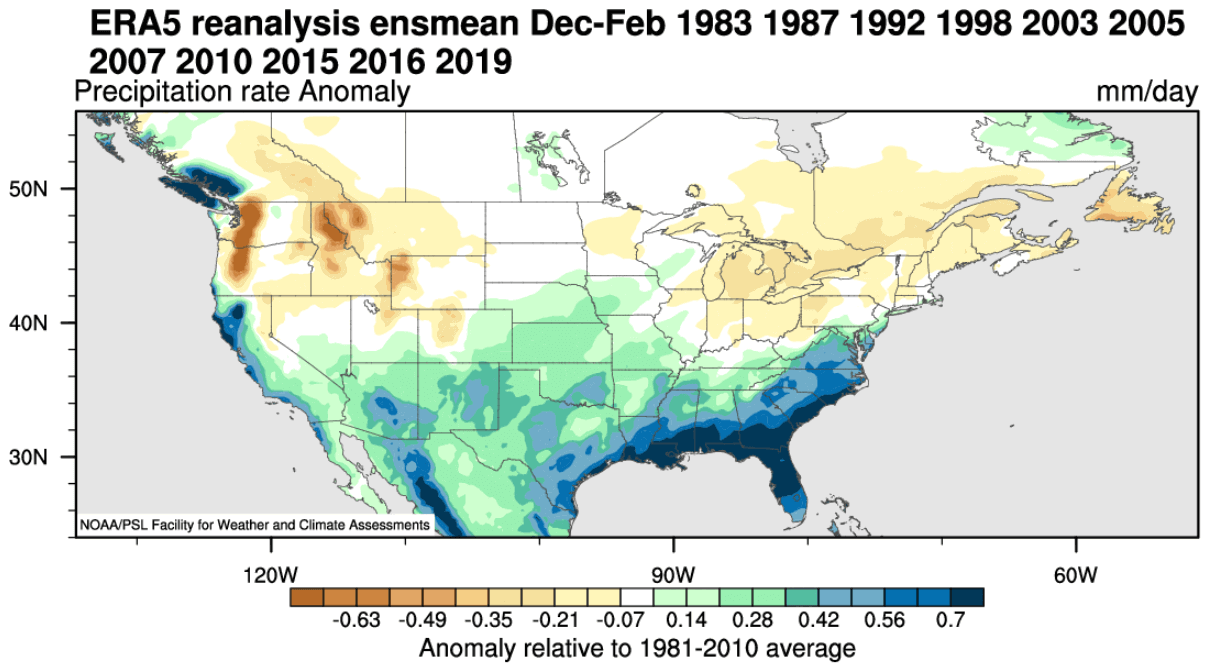
But speaking of precipitation, what about snowfall? The data shows that the El Nino jet stream also changes the snowfall potential over North America as the pressure systems take a different path.
Usually, we see less snowfall in the northern United States during an El Nino Winter. But more snowfall is seen in the central and southern United States during an El Nino in the image below by NOAA-Climate. More snowfall is also seen over parts of the mid-Atlantic and higher elevations of the southwestern United States.
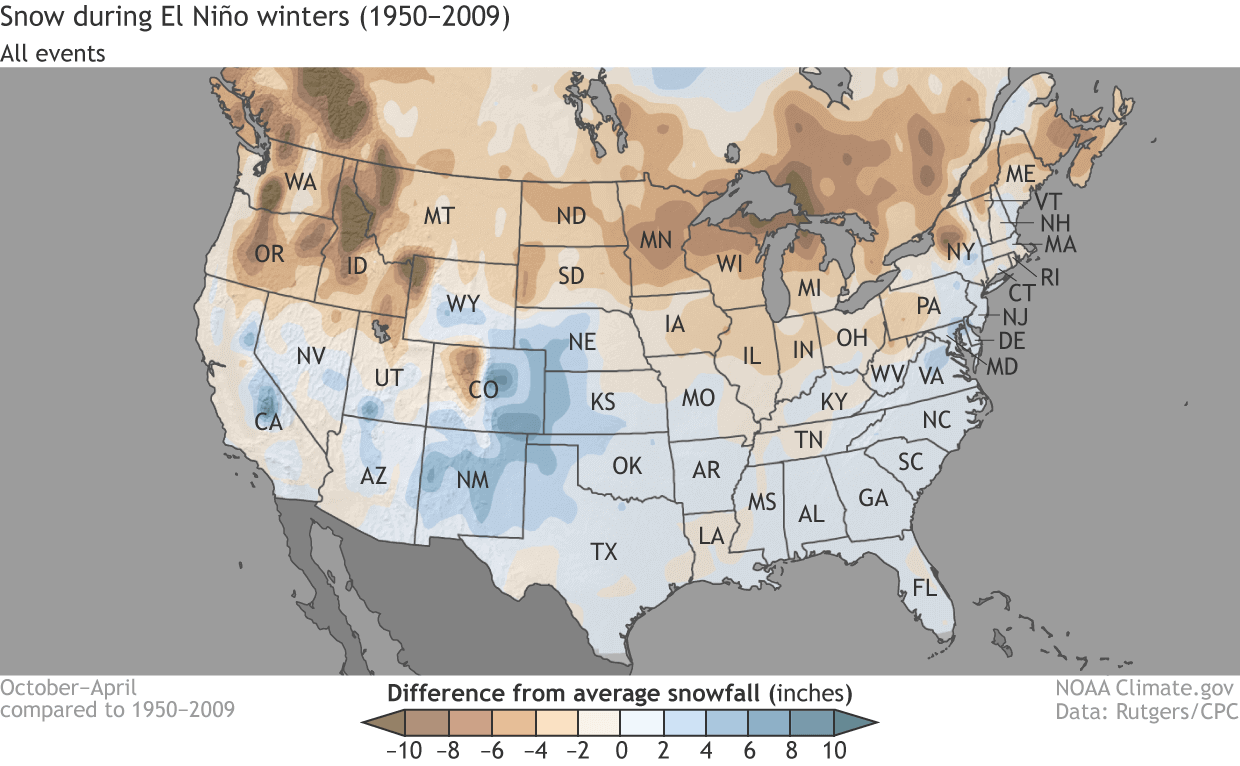
This is mainly due to low-pressure systems trailing across the southern United States. With more moisture available, the chances of snowfall increase in the southern half of the country. But a lot depends on the availability of the cold air from the North.
Now, we have an idea of what to expect from a typical El Nino Winter based on actual past observations. But we will look at the latest long-range snowfall predictions from actual models, as historical data can only tell you so much.
WINTER 2023/2024 LATEST SNOWFALL PREDICTIONS
The format of our snowfall forecast breakdown is simple. We will look at two well-established seasonal weather forecasting systems. The first is the ECMWF, and the second model is the UKMO.
You will first see the average snowfall forecast for the meteorological Winter period (December-January-February), and then we will do a monthly breakdown. There are a lot of details in the monthly forecast that the whole seasonal average does not show.
ECMWF WINTER 2023/2024 SNOWFALL FORECAST UPDATE
As always, we will start with the ECMWF, the most often used and highly regarded seasonal forecasting system.
First, looking at the average image for Europe, we can see a weak snowfall forecast. Most of the continent is forecast to have less snowfall than normal, except for parts of central Europe and Scandinavia.
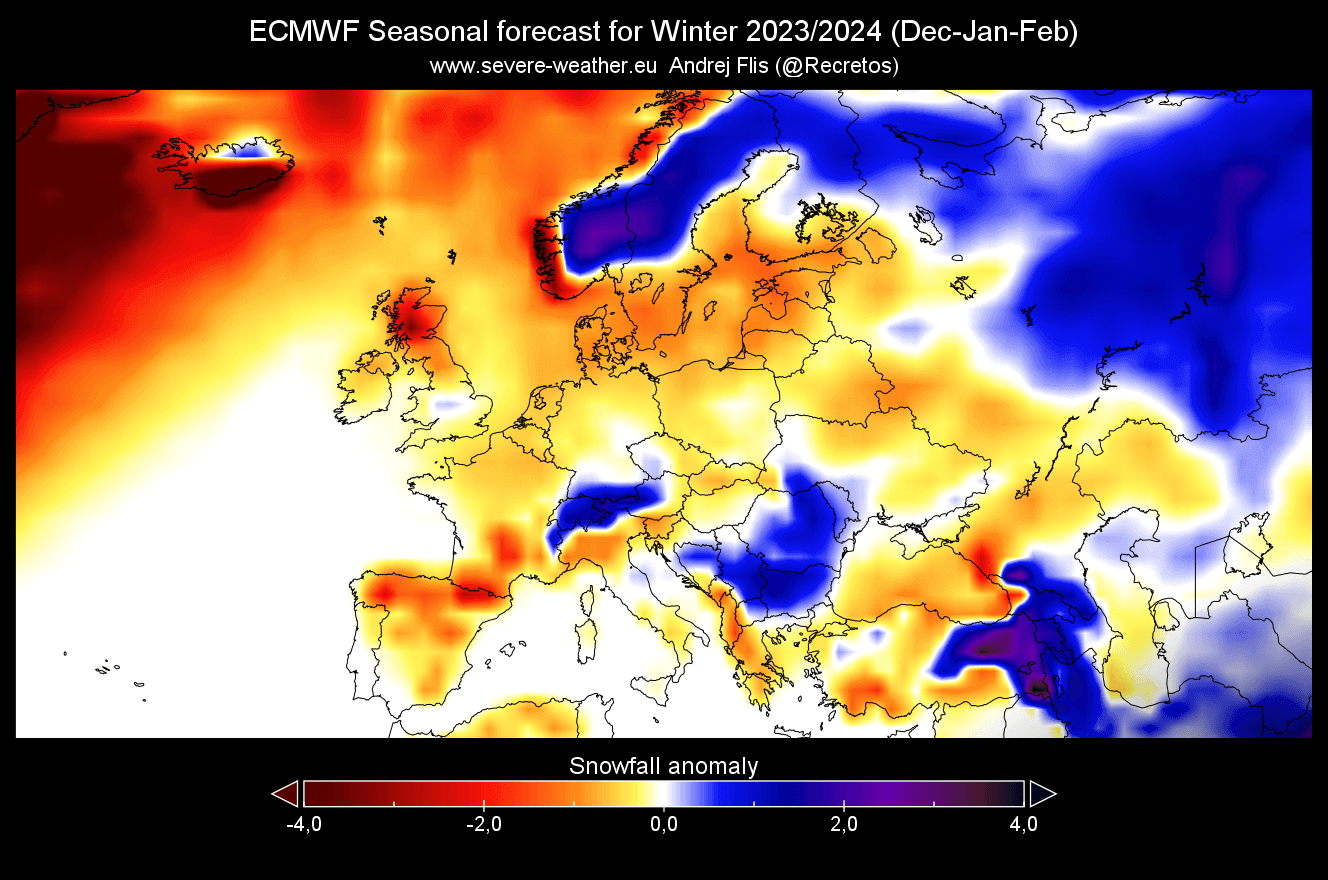
The December snowfall forecast shows most of the continent with negative snowfall amounts, apart from far north. This is likely linked to a more southwesterly flow over most of Europe.
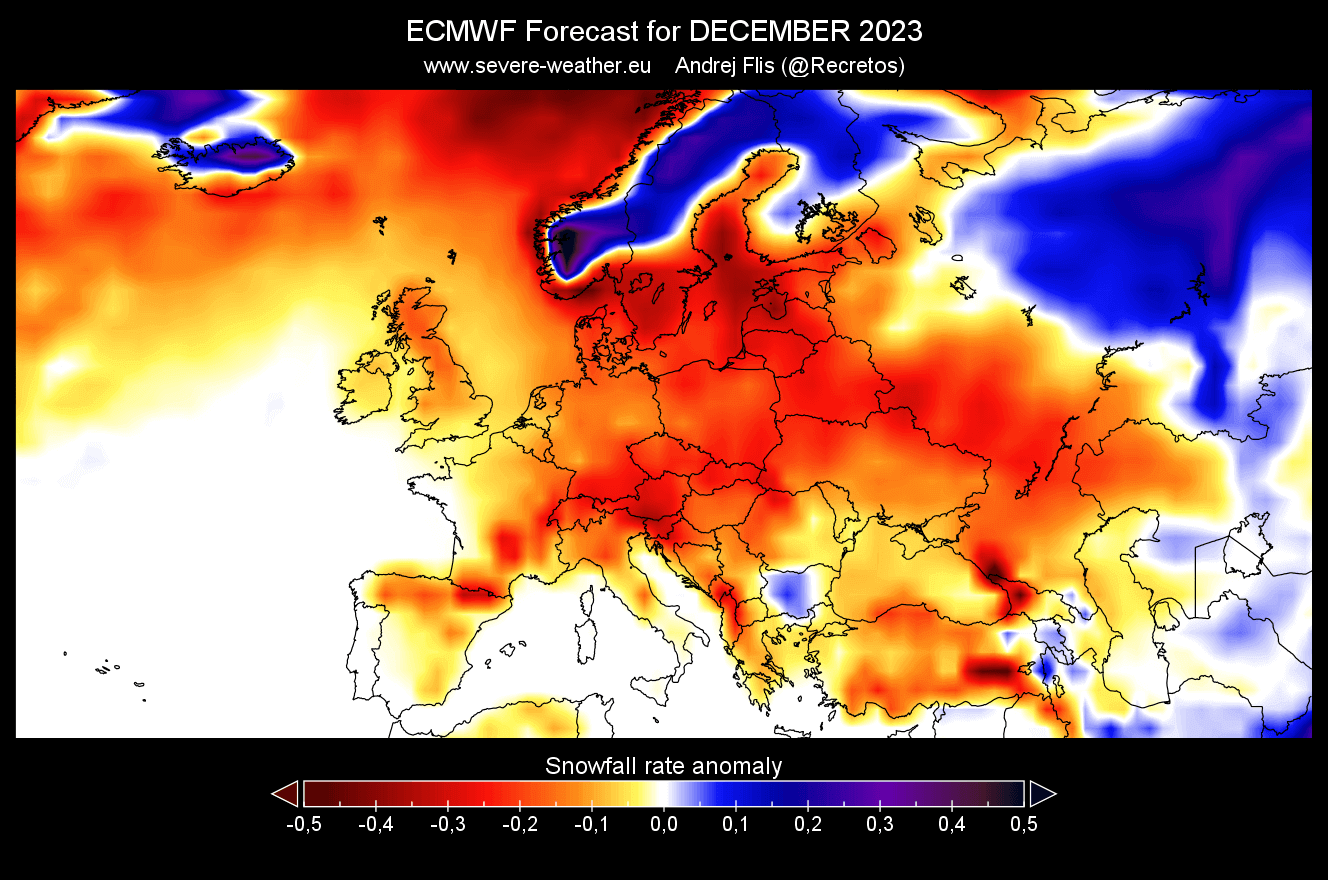
In the January forecast, you can see a much different picture, with snowfall potential increasing strongly over much of central countries. This corresponds to a more northerly flow starting to establish.
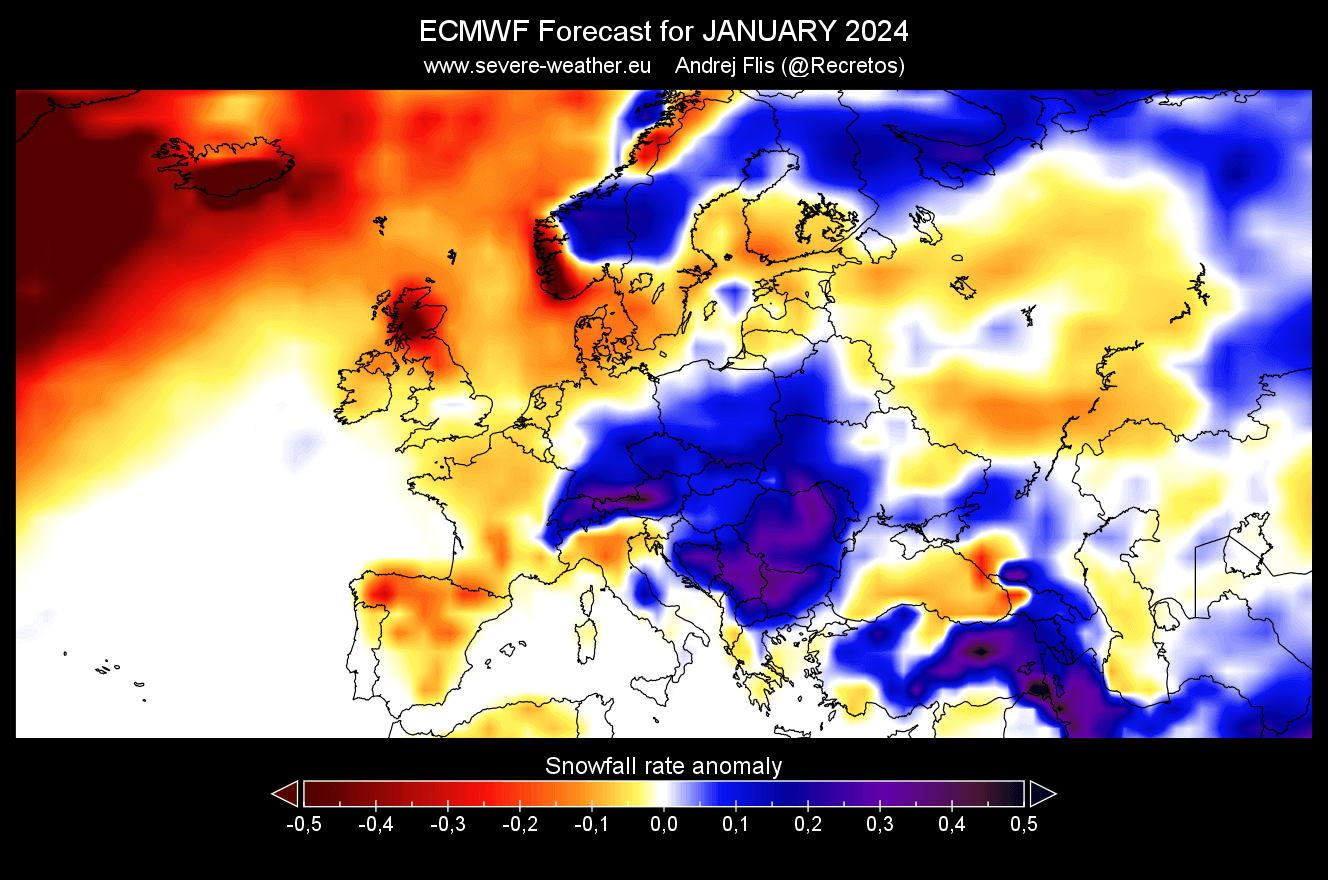
February shows even more improvement. More snowfall is forecast over much of the continent, apart from the southwestern and southern parts.
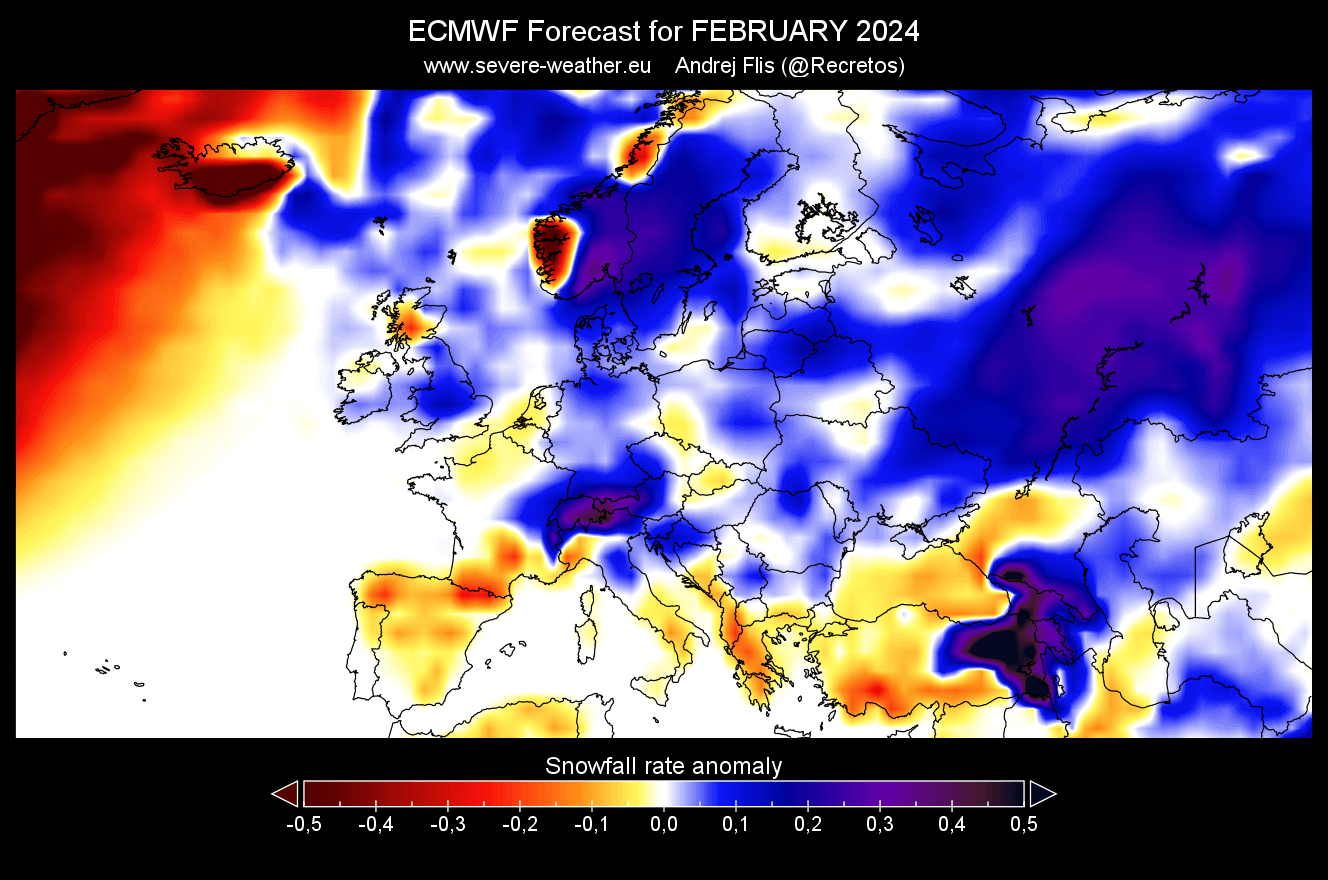
But anomalies can only tell us so much. In the next image below, you can see the average monthly snowfall rate. You can see that despite negative anomalies over parts of Europe, there are still snowfall events over the continent. So, even if the forecast calls for less snow, that does not mean no snow.
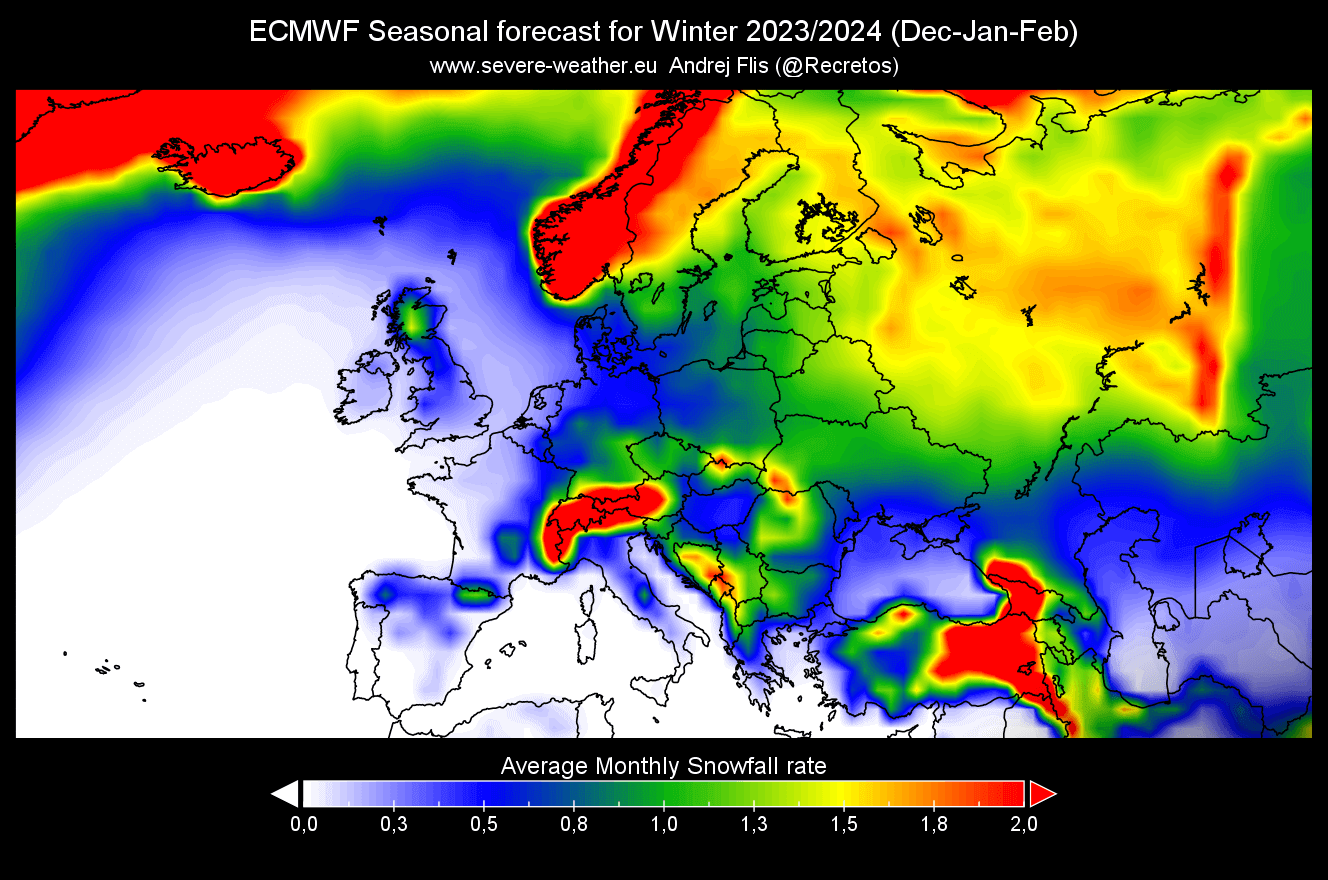
NORTH AMERICA ECMWF SNOWFALL PREDICTION
Over North America, we see a similar seasonal average forecast, with most of the United States having below-average snowfall. The exception is the southern and southeastern United States, which is expected for an El Nino Winter. Eastern Canada also shows a higher-than-normal snowfall amount.
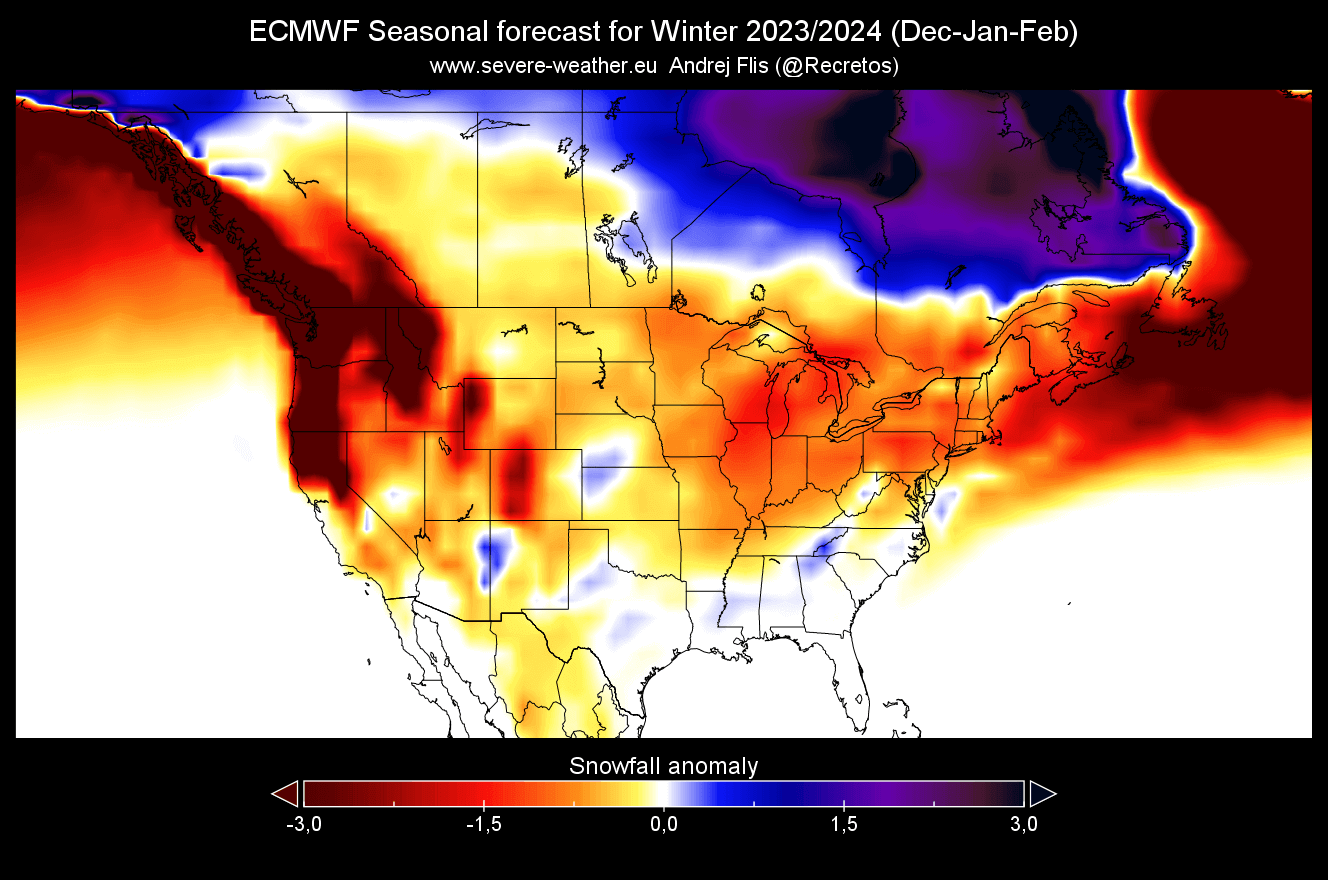
But remember that this is the 3-month average snowfall forecast. There is much more detail in the month-to-month patterns, especially in mid-to-late Winter.
That can be seen right away in the December snowfall forecast below. You can see increased snowfall potential across the southern and central United States and up into the northern United States. Most of southern and eastern Canada also shows increased snowfall potential.

January snowfall forecast shows a shift in the weather pattern. An increased snowfall potential is now seen over the northeastern United States, over the states down along the east and south coast, and the upper Midwest.

The January snowfall forecast also shows continued increased snowfall across eastern and southeastern Canada. Less snowfall is forecast for the Pacific Northwest, a common pattern in El Nino Winters.
Looking at the February snowfall forecast, you can see the snowfall potential now shifting again, this time towards the southern half of the United States. This is common for an El Nino Winter, just like the much-reduced snowfall potential over the Pacific Northwest.
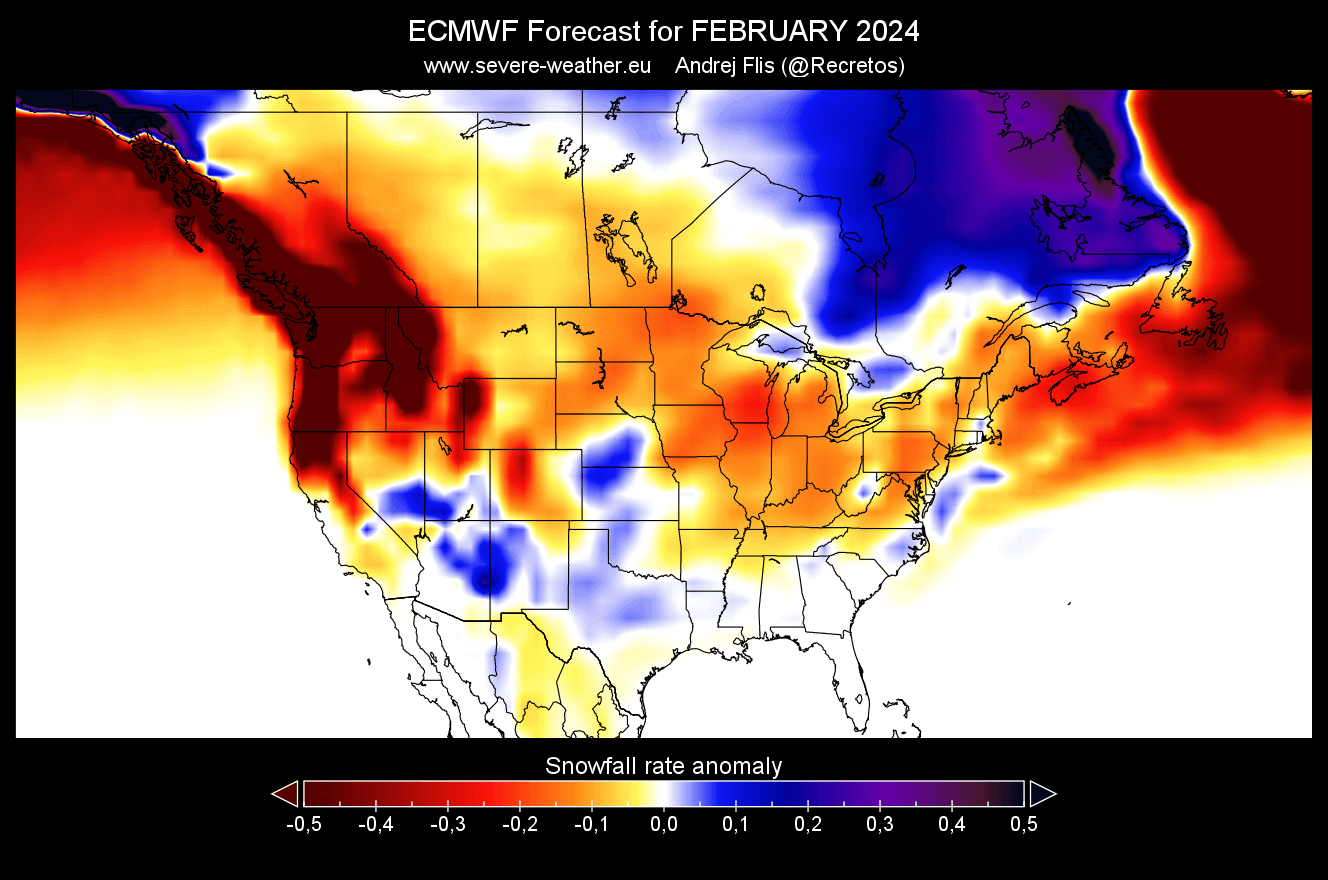
Also, for the United States and Canada, the average monthly snowfall rate forecast shows the reach of snowfall events. You can see it reaching down into the parts of the southern Plains and, to a smaller extent, across the southeastern United States.

UKMO WINTER 2023/2024 SNOWFALL FORECAST UPDATE
Long-range weather forecasting is not an easy task. We only look at trends and probabilities, but the variation is still key. The more forecast data you can look at, the better idea you can get what the most possible scenario is. Or sometimes, you can get even more confused.
As you can never trust a single forecast model, we use the UKMO long-range forecasting system along the ECMWF. It is run by the United Kingdom Met Office, which is where the initials UKMO come from.
First, looking at the seasonal average for Europe, we can see another weak snowfall forecast identical to the ECMWF. Most of the continent is forecast to have less snowfall than normal, except for some central and northern parts.
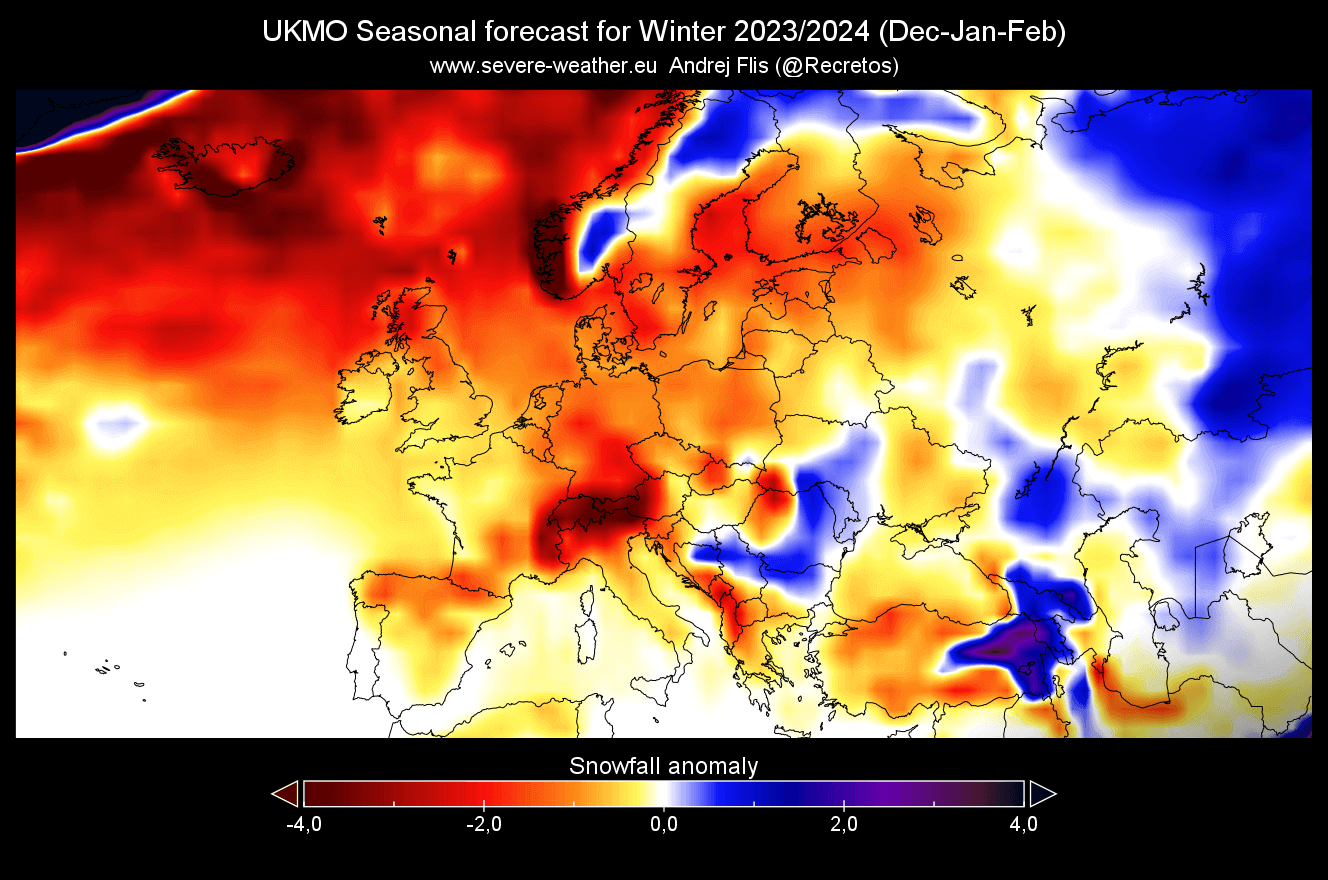
The December snowfall forecast shows a grim snowfall outlook, with most of the continent with less snowfall than normal. This is identical to ECMWF, which gives this scenario a higher probability.
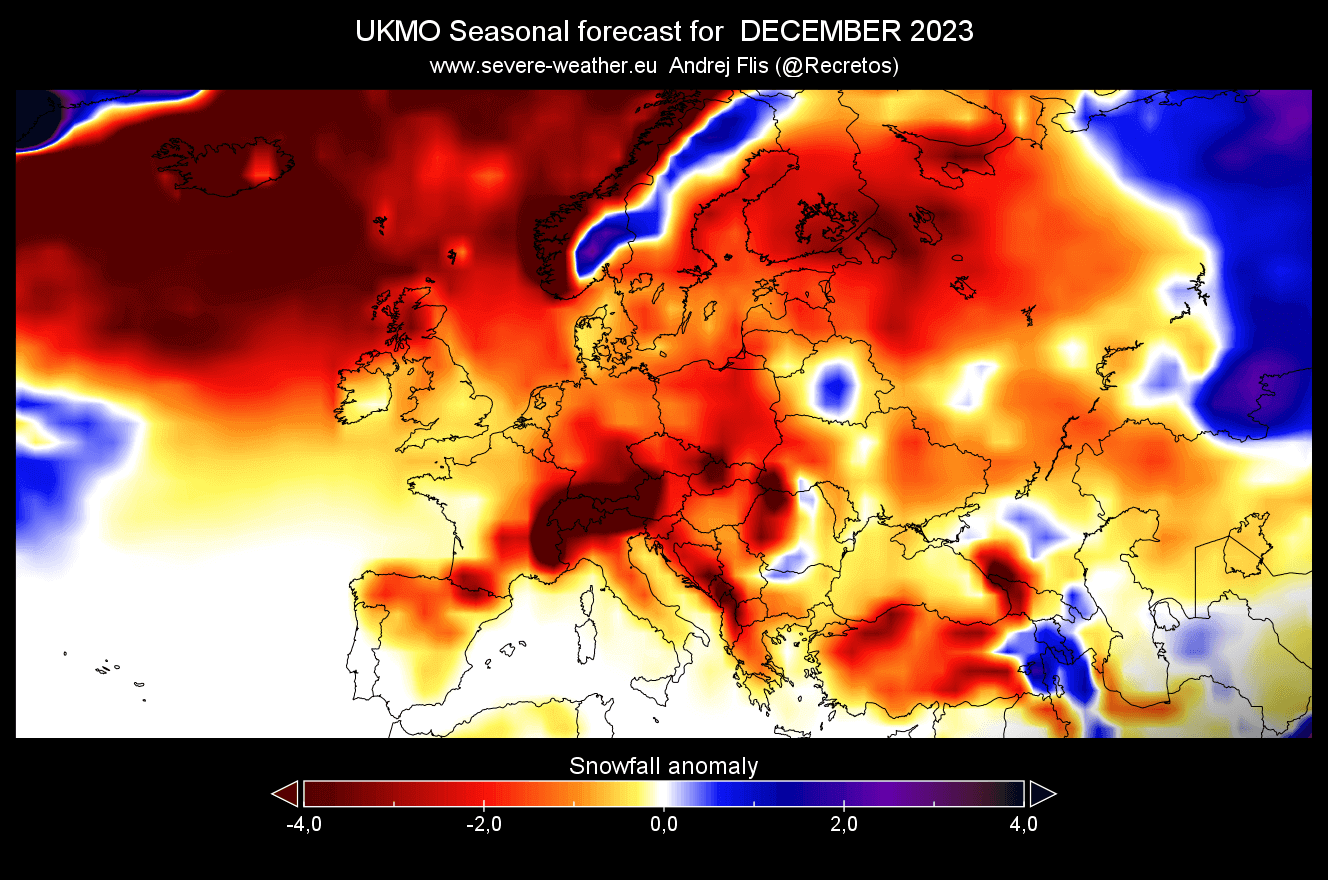
Looking at the January snowfall forecast, there is not much improvement except for some parts of central Europe and the far North.

We have seen a pattern shift in the January forecast from ECMWF, but the UKMO model does not seem to be picking up on a signal for a major pattern change early next year.
But looking at the February snowfall forecast, you can see more snowfall across parts of Central Europe and towards the northeast. So this model does have a pattern change in the forecast, but a bit later in Winter.
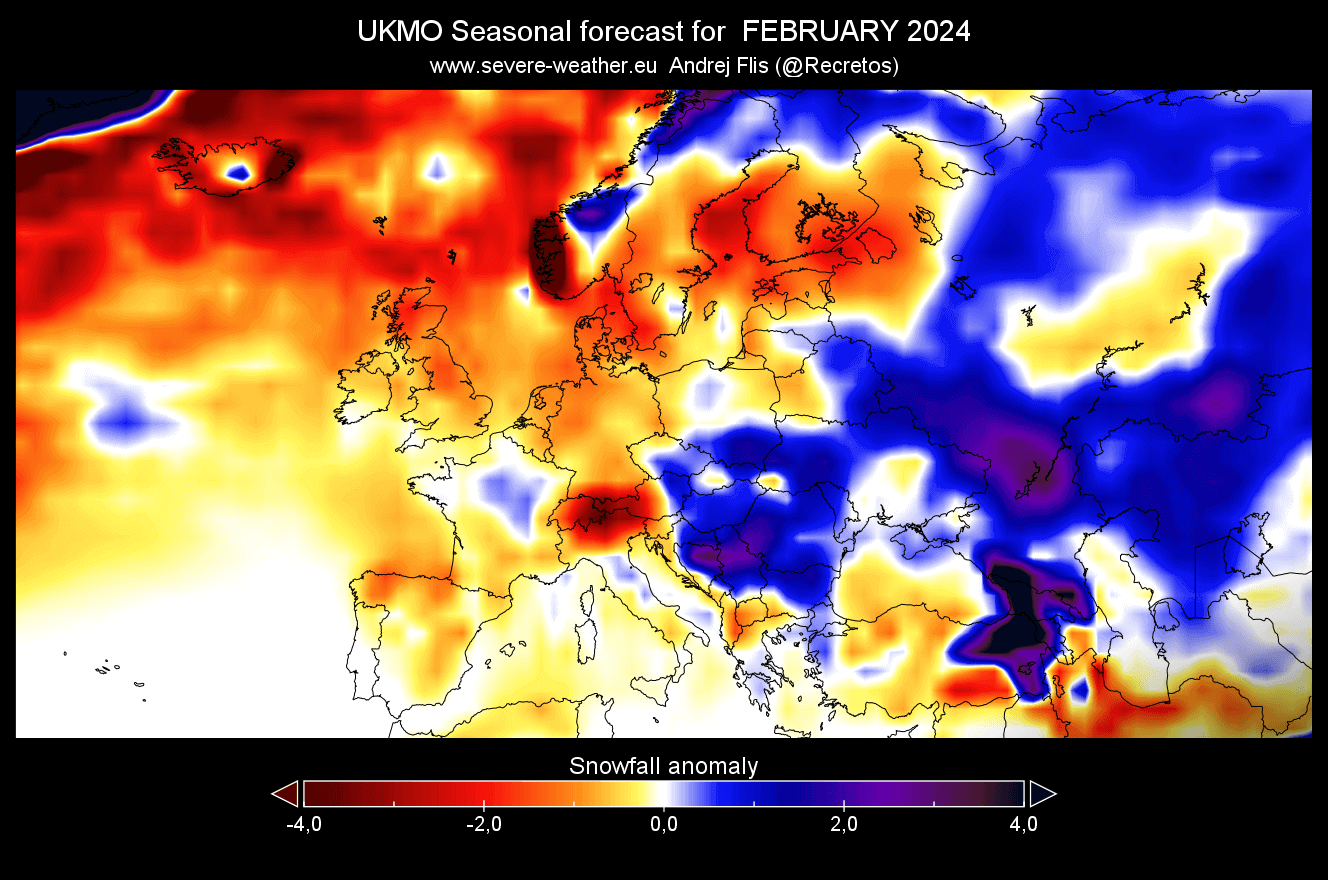
NORTH AMERICA UKMO SNOWFALL PREDICTION
The average seasonal forecast for the United States and Canada shows a reduced snowfall potential across much of the United States and southwestern Canada. But this is a seasonal average from December to February, so we will look at each month individually.

The December snowfall forecast shows further snowfall increase across the western United States and much of eastern Canada. This is similar to the ECMWF snowfall forecast, but the main snowfall area is moved a bit more to the west.
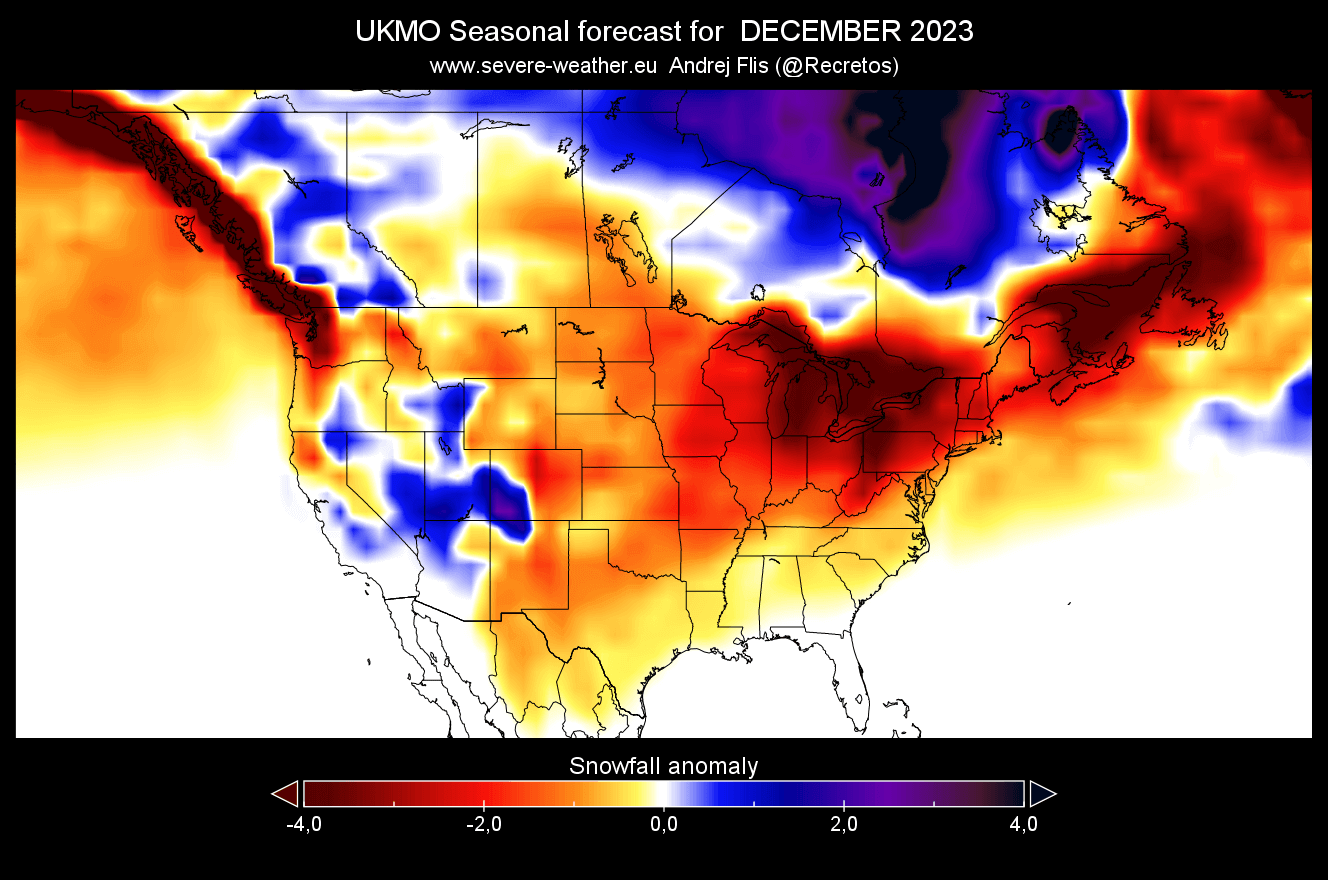
January snowfall forecast shows the increased snowfall potential mostly over the southern and northeastern United States. The rest of the country is forecast with less snowfall than normal. Canada shows a more varied distribution of snowfall anomalies.
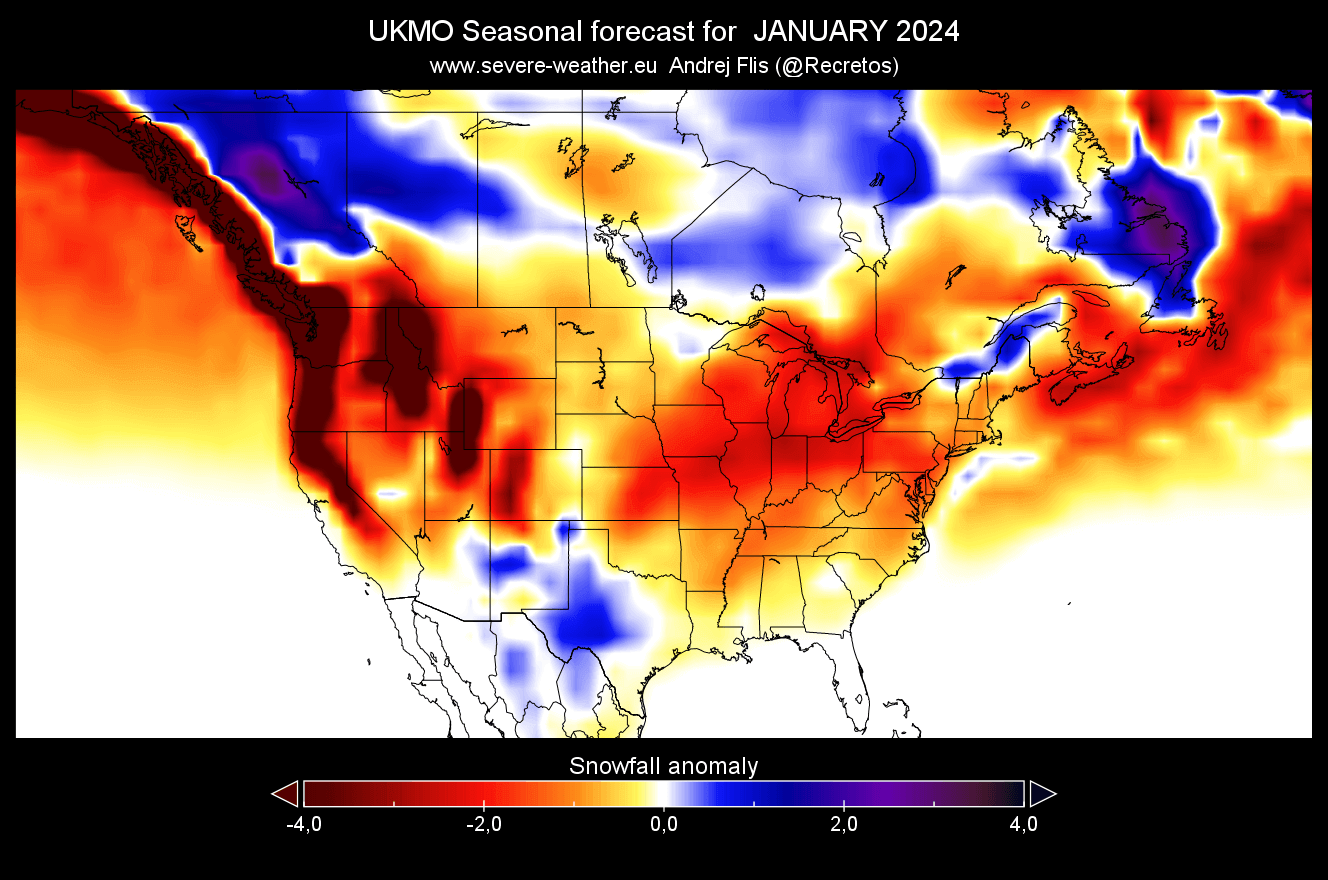
The UKMO February snowfall forecast shows no major improvement except for the southwestern United States, some parts of the eastern United States, and the upper Midwest. The rest of the country shows less snowfall than usual.

This is a different forecast from the ECMWF, but that is to be expected as the forecast length increases. Also, looking at last year, the ECMWF performed better in this range than the UKMO model.
Also, the El Nino event will have a stronger atmospheric presence in the coming weeks. That should improve the overall forecast quality of the future model calculations, and models are starting to get closer together in their forecasts.
NOAA OFFICIAL WINTER 2023/2024 FORECAST
We can also track snowfall potential on normal temperature and precipitation Winter forecasts. The highest snowfall potential is usually in regions with colder temperatures and more precipitation.
Below is NOAA’s official Winter 2023/2024 forecast update for the United States released this month. Note that we chose to show the January-March period, as it currently looks to have more potential for colder scenarios.
The first image shows the temperature probability, with warmer chances in the northern United States. The southern half of the country is in a neutral zone, the same as the models above indicate. A colder signal is emerging in the southern United States, but this will likely shift further to the east as we get closer to Winter.

The colder temperatures in the southern United States are something that the ECMWF and UKMO have hinted at in their temperature forecast. That is linked to the subtropical jet stream and a blocking high-pressure system over Canada/Greenland.
The official precipitation forecast is also similar to the typical El Nino Winter. We see an equal-to-higher probability for more precipitation (and snowfall) over the southern and eastern parts of the United States. Less precipitation is expected across the northern parts of the United States.
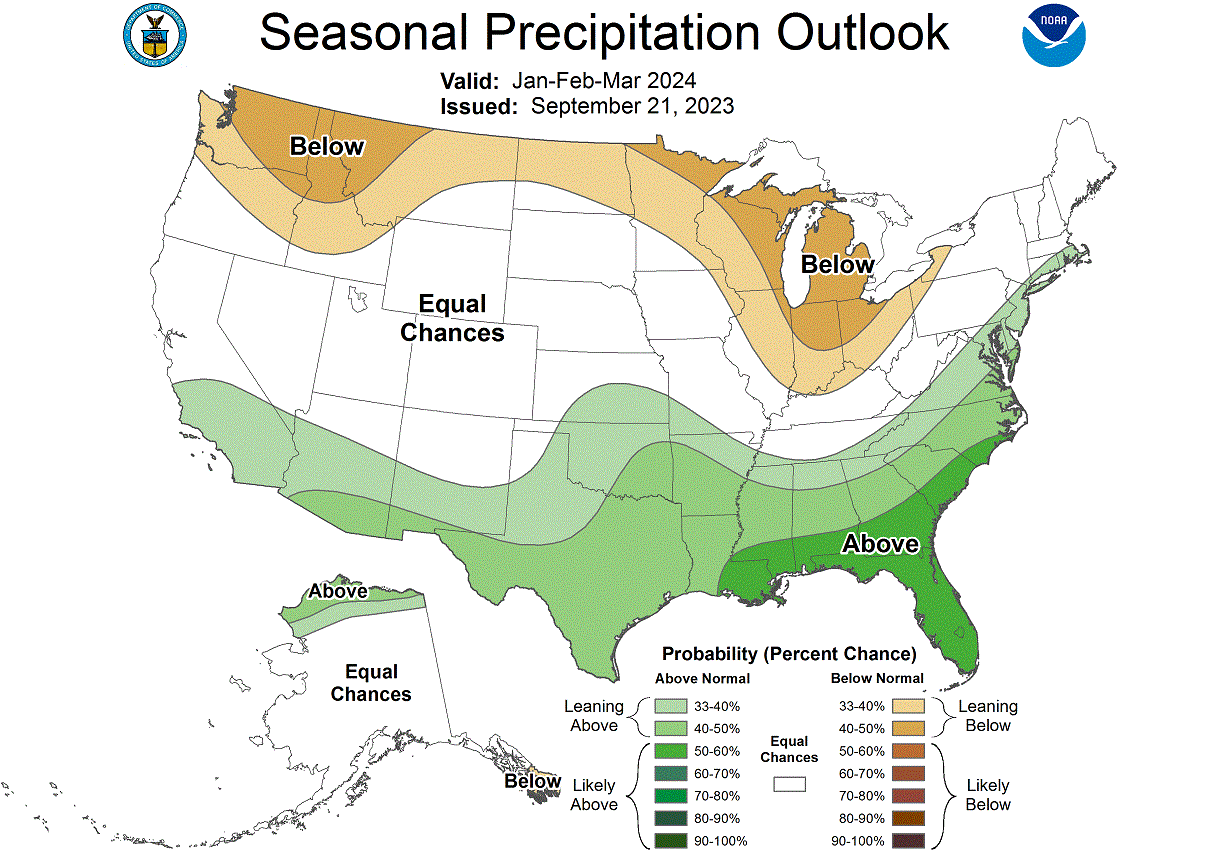
Despite having warmer/colder temperature anomalies, it still depends on how much cold air is available for snowfall. For example, a warm temperature anomaly in the northern United can still be colder than a cold anomaly in the southern United States.
So, parts of the northern United States can still have more snowfall than the southern half in an El Nino Winter despite being forecast warmer than normal. This is something that we will look at closely as we near the official start of Winter.
We will keep you updated on other developing weather trends, so bookmark our page. Also, if you have seen this article in the Google App (Discover) feed, click the like button (♥) there to see more of our forecasts and our latest articles on weather and nature in general.
Don’t miss:
Winter 2023/2024 Forecast: September Update for the United States, Canada and Europe